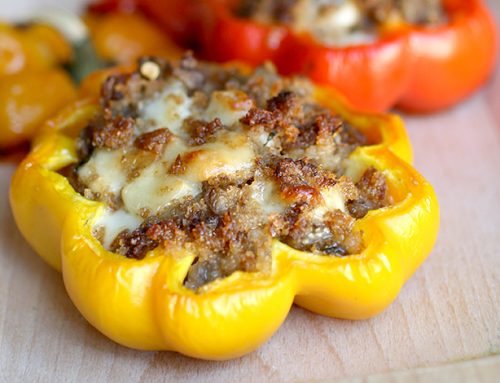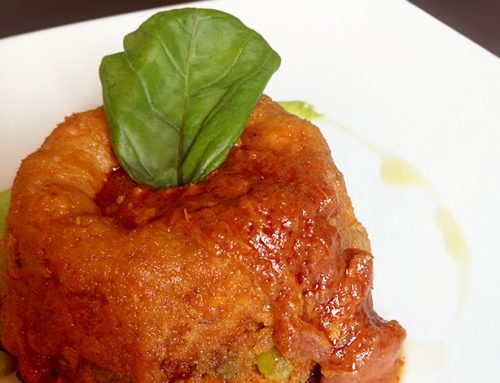Often during the week, Francesco’s parents go around to visit fairs and markets, and a couple of weeks ago they brought us a treasure!
They were at the Festival of Bruschetta in Casaprota, near Rieti, and found a manufacturer that sold a 24 months aged Vezzena from Trentino, organically produced.
Vezzena is an italian cheese, very tasty and aromatic, produced in the “Malga”, a typical high-altitude Alpine hut, where local farmers spend winters and prepare cheese.
News on Vezzena can be found here and here, the flavor is outstanding, with a mellow and slightly bitter aftertaste.
But eating it by itself was somehow a waste, so I started thinking: now what can we do with this fantastic formaggione?
I went peering among all my recipes from Altoadige (I lived a couple of years in Ortisei, and I adored their cuisine), until I found how to make cheese canederli, which the recipe suggests should be precisely as spicy as the Vezzena.
The canederli are a dish of ancient and brilliant reuse of leftovers, a specialty of Trentino-Alto Adige (these bread dumplings are the Italian version of Austrian and German Knodel) and with regard to the bread and cheese combination, look at what nutritional biotherapy says:
“In general, we can say that cheese is very full and rich in nutrients. Long ago, in farming culture, cheese was consumed during periods of intense physical work, when there was a lot of sweating.
The farmer, often eating only bread and cheese, was able to work hard until the evening […] in a not too distant past, when the heating in winter was not as continuous and intense as today, the caloric power of cheese was used to deal with the cold”
and again:
“Among the other nutrients found in cheese, remember tyrosine, a precursor molecule of catecholamines (adrenaline, noradrenaline and other neurotransmitters), which are raising the state of wakefulness and attention, increasing the excitability of the central nervous system; calcitonin, which too has an excitatory action on the nervous tone; and serotonin, with its relaxing effect inhibited in cheese because of the action of curd”
For this reason, nutritional biotherapy recommends to avoid the use of cheese in the evening, because it can disturb sleep (be careful not to prepare baby food with cheese in the evenings, if you do not want to go crazy!); on the contrary, it is recommended for healthy children growth, during pregnancy and lactation, during dentition, and in general for people who use a considerable expenditure of physical and mental energy, or that cannot afford a drop in nervous tone or attention.
There’s so much more useful information on cheese I’d like to give you, but I’ll write it in some other post about cheese, otherwise we’ll never get out of here…
Why don’t I just write down the recipe:
Ingredients:
225 grams of bread
150 ml of whole milk
1 small onion
30 grams of butter
175 grams of “Malga” cheese
40 grams of flour 0
3 eggs
2 tablespoons parsley
nutmeg
one pinch of salt
pepper
Cut the bread into slices and then into cubes of 1 square cm, put it in a bowl with warm milk, cover with a clean cloth and allow the cubes to swell up, for about twenty minutes. Stir occasionally so that the cubes are soaked in liquid evenly.
The bread must be nicely moist, but not reduced to mush.
Meanwhile, cut the onion, diced very small, and sauté in butter until it is golden, then allow to cool.
Whisk the eggs with the nutmeg, salt and pepper, and cut the cheese into cubes.
Combine the onion and the mixture with the eggs to the bread, stir and add the flour at the end, as it will give more consistency.
Mix everything well with your hands, then let the mixture stand a few hours, stirring occasionally, so that the flavors may blend well.
Then wet your hands and shape the mixture into 8 balls, roughly 6 centimeters in diameter.
Set a large pot of salted water to boil, then turn down the fire, pour very gently the canederli in the water and let them simmer (at extremely low fire) for about 20 minutes.
If you have doubts about the consistency of the mixture, try to soak in water a small ball as a test first, and if it dissolves, add a little flour to the bread mixture.
This type of canederli are served with a tomato soup, or with cream and mushrooms. I have tested them with the tomato, but I must say that the taste of cheese it is a bit covered, therefore next time maybe I’ll prepare the tomato soup with some cream to reduce its assertiveness.
You have no idea how many kinds of canederli there are: sweet, salty, fried, polenta, semolina, and I know that I’ll try a lot of them. Once tasted, they become necessary, also if you want to reuse stale bread.
And then, think about how such a dish can be cheap!
One last thing: If you do not find a good Vezzena, you can replace it with parmesan cheese or a pungent, well aged provolone; try it, and do keep me posted on the variations…





Scrivi un commento